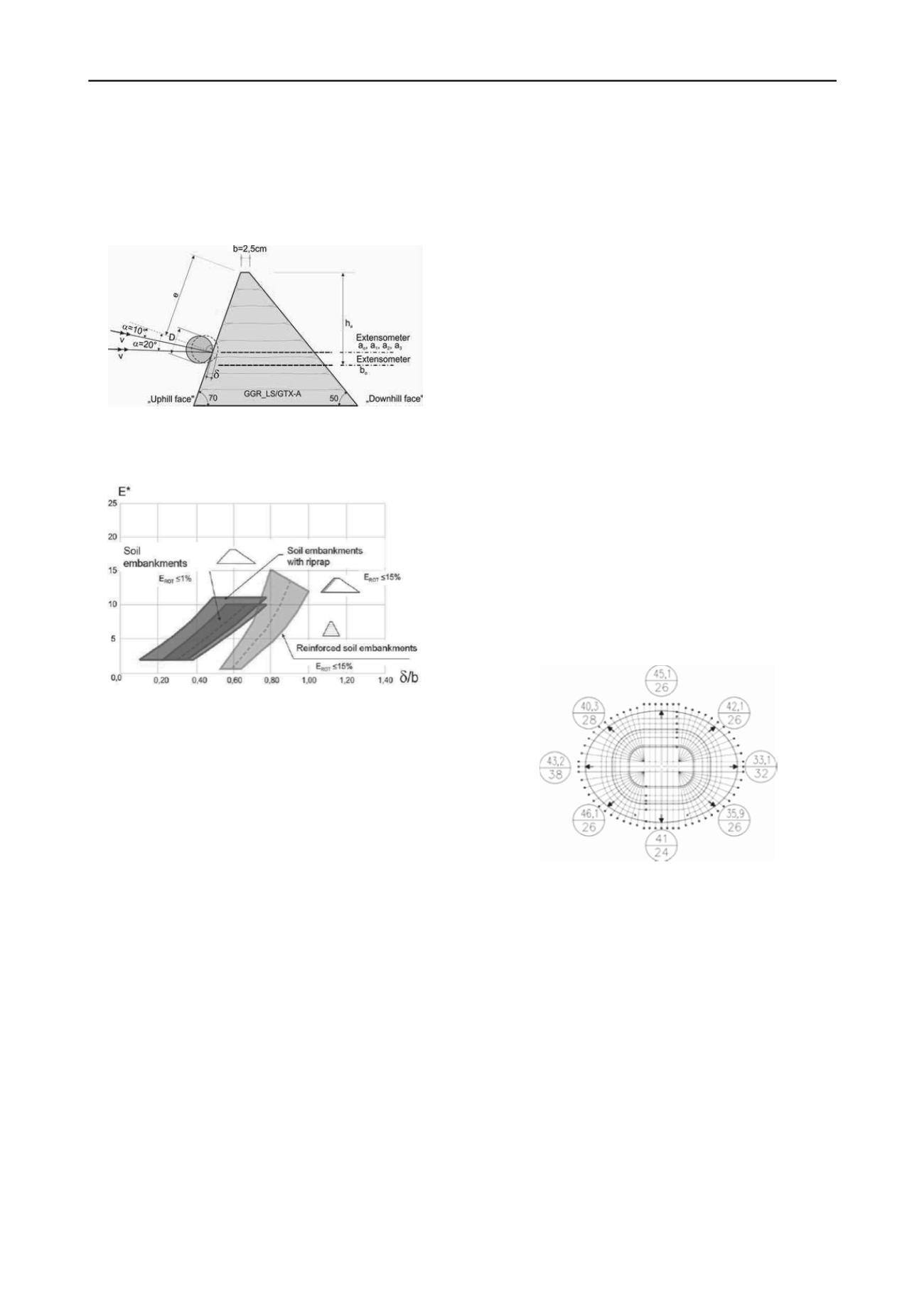
3092
Proceedings of the 18
th
International Conference on Soil Mechanics and Geotechnical Engineering, Paris 2013
hitting rock block (or sphere, in the small scale experiments) to
roll on or jump over the embankment crest, and also propose a
simple design chart to estimate the penetration
into the
embankment as a function of a non dimensional energetic
parameter E* (Figure 11).
Figure 10. Small scale model rock-fall protection embankment used in
the tests (
Hoffmann et al. 2013
).
Figure 11. Summary of the results of the rock-fall experimental tests on
small scale embankments (
Hoffmann et al. 2013
). E* is a dimensionless
energetic parameter defined by the authors as relative impact energy,
is the depth of penetration of the hitting sphere and b is the crest width
(see Figure 10).
The other five papers belonging to this subsession share the
characteristic of referring to geotechnical problems encountered
in the problematic soils and in the extremely seismic areas of
Eastern Europe and Western Asia, in states which were recently
born after the collapse of Soviet Union.
Two of these papers deal with the large works under course
in Sochi (Russia), where the XXII
th
Winter Olympic Games and
the XI
th
ParaOlympic Games will be held in 2014. The papers
describe the geological and geotechnical features of the sites in
which the Olympic Village and the sport facilities will be
located. Two clusters are under construction: one in the coastal
area and one on the mountains, giving rise to what claims to be
the most compact venue ever for such an event. The whole area
is highly seismic.
Fedorovsky et al. (2013)
describe the complex geological
conditions of the mountainous cluster, with chaotic, widely
graded superficial soils over a base argillite formation. Since in
some cases the facilities had to be realized operating slope cuts,
slope stability analyses were carried out using different
methods. Eventually, stabilizing interventions were conceived
to meet safety requirements: soil nails were adopted to avoid
local instability around the slope cuts, while rows of piles (in
some cases anchored at the top) were used to stabilize the slope.
No details are given in their paper on the design of the
stabilizing interventions, and more than one doubt exist on the
effectiveness of the adopted numerical approach for the design
of rows of slope stabilizing piles. As a matter of fact, it is well
known that piles give a contribution only if the slide is active, as
the stabilizing shear forces they generate are the result of soil-
structure interaction. What they usually do is slowing down
more than stopping the slide (Lirer and Flora 2008, Lirer 2012),
unless extremely heavy structures are realized. A realistic
numerical calculation should allow soil flow among the piles,
otherwise completely unrealistic interaction pressures may be
calculated. Even though this seems to indicate than only
complex 3D analyses are necessary, some codes allow such a
flow even in 2D analyses.
The second paper on the new constructions in Sochi is the
one by
Petrukin et al. (2013)
, who describe some of the
geotechnical problems posed by the design of three large
buildings in the coastal area, gives some information on the
foundation solutions proposed, and briefly discuss the issue of
pipelines design. The first building is the Big Ice Arena, seating
12000 people, resting on a complex deposit composed of layers
ranging from coarse gravels to sandy clayey. Shallow
foundations were chosen for this large building, made of a
number of rafts having thicknesses from 0.6 m to 1.4 m,
separated by joints. The displacements induced by the
construction were monitored, and compared with the predicted
ones (Figure 12). The reported comparison refers to the end of
construction, and shows a general underestimate of the values of
the absolute displacements. The authors do not say anything on
the progress of consolidation settlements, and therefore it is not
said if further displacements are expected in time because of
pore pressure increments dissipation. However, the calculations
were able to give the order of magnitude of the absolute and
relative settlements. The second case described in this paper is
the one of a tall building hosting the Organizing Committee of
the Olympic Games. The building is founded on a thick layer of
clay which,
Figure 12. Mean values (mm) of measured (numerator) and calculated
(denominator) settlements of the Big Ice Arena raft footing in Sochi
(Russia) (
Petrukin et al. 2013
).
below a depth of few meters, has extremely poor mechanical
properties. Consequently, the building has been founded on
piles, whose seismic design was the geotechnical challenge. A
refined solution was chosen in this case (Figure 13): a layer (40
cm) of dense sand reinforced with geogrids was interposed
between the piles and the foundation raft. With such an elegant
solutions, the piles solve the static problem in terms of bearing
capacity and settlements, but do no interact (neither
kinematically nor inertially) with the superstructure during
earthquakes, thus avoiding the risk of large seismically induced
bending moments at the piles caps.
A similar solution was adopted for part of the foundations of
a hotel, which is the third building analysed in this paper, while
the remain part of the foundations were shallow, because
directly resting on a thick deposit of sand and gravel.
Petrukin
et al. (2013)
claim that the interposition of an intermediary sand


